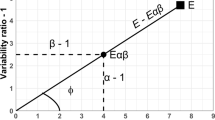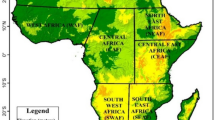Abstract
The global circulation models (GCMs) are useful tools for simulating climate change, projecting future temperature changes, and therefore, supporting the preparation of national climate adaptation plans. However, different GCMs are not always in agreement with each other over various regions. The reason is that GCMs’ configurations, module characteristics, and dynamic forcings vary from one to another. Model ensemble techniques are extensively used to post-process the outputs from GCMs and improve the variability of model outputs. Root-mean-square error (RMSE), correlation coefficient (CC, or R) and uncertainty are commonly used statistics for evaluating the performances of GCMs. However, the simultaneous achievements of all satisfactory statistics cannot be guaranteed in using many model ensemble techniques. In this paper, we propose a multi-model ensemble framework, using a state-of-art evolutionary multi-objective optimization algorithm (termed MOSPD), to evaluate different characteristics of ensemble candidates and to provide comprehensive trade-off information for different model ensemble solutions. A case study of optimizing the surface air temperature (SAT) ensemble solutions over different geographical regions of China is carried out. The data covers from the period of 1900 to 2100, and the projections of SAT are analyzed with regard to three different statistical indices (i.e., RMSE, CC, and uncertainty). Among the derived ensemble solutions, the trade-off information is further analyzed with a robust Pareto front with respect to different statistics. The comparison results over historical period (1900–2005) show that the optimized solutions are superior over that obtained simple model average, as well as any single GCM output. The improvements of statistics are varying for different climatic regions over China. Future projection (2006–2100) with the proposed ensemble method identifies that the largest (smallest) temperature changes will happen in the South Central China (the Inner Mongolia), the North Eastern China (the South Central China), and the North Western China (the South Central China), under RCP 2.6, RCP 4.5, and RCP 8.5 scenarios, respectively.









Similar content being viewed by others
References
Allan C, Xia J, Pahl-Wostl C (2013) Climate change and water security: challenges for adaptive water management. Curr Opin Environ Sustain 5(6):625–632
Allen CD, Macalady AK, Chenchouni H, Bachelet D, McDowell N, Vennetier M, Kitzberger T, Rigling A, Breshears DD, Hogg E (2010) A global overview of drought and heat-induced tree mortality reveals emerging climate change risks for forests. For Ecol Manag 259(4):660–684
Buser CM, Künsch H, Lüthi D, Wild M, Schär C (2009) Bayesian multi-model projection of climate: bias assumptions and interannual variability. Clim Dyn 33(6):849–868
Coquard J, Duffy P, Taylor K, Iorio J (2004) Present and future surface climate in the western USA as simulated by 15 global climate models. Clim Dyn 23(5):455–472
Deb K (2001) Multi-objective optimization using evolutionary algorithms. Wiley, Hoboken
de Oliveira JAP, Doll CN, Moreno-Peñaranda R, Balaban O (2014) Global environmental change. Springer, Berlin, pp 461–468
Duan Q, Phillips TJ (2010) Bayesian estimation of local signal and noise in multimodel simulations of climate change. J Geophys Res 115:D18123. doi:10.1029/2009JD013654
Duan Q, Sorooshian S, Gupta V (1992) Effective and efficient global optimization for conceptual rainfall-runoff models. Water Resour Res 28(4):1015–1031
Feng J, Lee D-K, Fu C, Tang J, Sato Y, Kato H, Mcgregor JL, Mabuchi K (2011) Comparison of four ensemble methods combining regional climate simulations over Asia. Meteorog Atmos Phys 111(1–2):41–53
Fischer A, Weigel A, Buser C, Knutti R, Künsch H, Liniger M, Schär C, Appenzeller C (2012) Climate change projections for Switzerland based on a Bayesian multi-model approach. Int J Climatol 32(15):2348–2371
Gao X, Shi Y, Song R, Giorgi F, Wang Y, Zhang D (2008) Reduction of future monsoon precipitation over China: comparison between a high resolution RCM simulation and the driving GCM. Meteorog Atmos Phys 100(1–4):73–86
Giorgi F, Coppola E (2010) Does the model regional bias affect the projected regional climate change? An analysis of global model projections. Clim Chang 100(3–4):787–795
Giorgi F, Francisco R (2000a) Evaluating uncertainties in the prediction of regional climate change. Geophys Res Lett 27(9):1295–1298
Giorgi F, Francisco R (2000b) Uncertainties in regional climate change prediction: a regional analysis of ensemble simulations with the HADCM2 coupled AOGCM. Clim Dyn 16(2–3):169–182
Giorgi F, Mearns LO (2002) Calculation of average, uncertainty range, and reliability of regional climate changes from AOGCM simulations via the “reliability ensemble averaging” (REA) method. J Clim 15(10):1141–1158
Gleckler PJ, Taylor KE, Doutriaux C (2008) Performance metrics for climate models. J Geophys Res 113:D06104. doi:10.1029/2007JD008972
Goldberg DE, Holland JH (1988) Genetic algorithms and machine learning. Mach Learn 3(2):95–99
Gosling S, Lowe J, McGregor G, Pelling M, Malamud B (2009) Associations between elevated atmospheric temperature and human mortality: a critical review of the literature. Clim Chang 92(3–4):299–341
Gosling SN, Warren R, Arnell NW, Good P, Caesar J, Bernie D, Lowe JA, van der Linden P, O’Hanley JR, Smith SM (2011) A review of recent developments in climate change science. Part II: the global-scale impacts of climate change. Prog Phys Geogr 35(4):443–464
Hagedorn R, DOBLAS-REYES FJ, Palmer T (2005) The rationale behind the success of multi-model ensembles in seasonal forecasting—I. Basic concept. Tellus Series a-Dynamic Meteorology and Oceanography 57(3):219–233
Hotelling H (1933) Analysis of a complex of statistical variables into principal components. J Educ Psychol 24:417–441
Hotelling H (1936) Relations between two sets of variables. Biometrika 28(3–4):321–377
IPCC (2007) Climate change 2007: the physical science basis. Contribution of Working Group I to the Fifth Assessment Report of the Intergovernmental Panel on Climate Change. Cambridge University Press, Cambridge
IPCC (2013) Climate change 2013: the physical science basis. Contribution of Working Group I to the Fifth Assessment Report of the Intergovernmental Panel on Climate Change. Cambridge University Press, Cambridge
Lambert SJ, Boer GJ (2001) CMIP1 evaluation and intercomparison of coupled climate models. Clim Dyn 17(2–3):83–106
Lobell DB, Burke MB, Tebaldi C, Mastrandrea MD, Falcon WP, Naylor RL (2008) Prioritizing climate change adaptation needs for food security in 2030. Science 319(5863):607–610
Miao C-Y, Ni J-R (2009) Variation of natural streamflow since 1470 in the Middle Yellow River, China. Int J Environ Res Public Health 6(11):2849–2864
Miao C, Ni J, Borthwick AG (2010) Recent changes of water discharge and sediment load in the Yellow River basin, China. Prog Phys Geogr 34(4):541–561
Miao C, Duan Q, Sun Q, Li J (2013) Evaluation and application of Bayesian multi-model estimation in temperature simulations. Prog Phys Geogr 37(6):727–744
Miao C, Duan Q, Sun Q, Huang Y, Kong D, Yang T, Ye A, Di Z, Gong W (2014) Assessment of CMIP5 climate models and projected temperature changes over Northern Eurasia. Environ Res Lett 9(5):055007
Min S-K, Hense A (2006) A Bayesian assessment of climate change using multimodel ensembles. Part I: global mean surface temperature. J Clim 19(13):3237–3256
Min S-K, Hense A (2007) A Bayesian assessment of climate change using multimodel ensembles. Part II: regional and seasonal mean surface temperatures. J Clim 20(12):2769–2790
Nelder JA, Mead R (1965) A simplex method for function minimization. Comput J 7(4):308–313
Phillips, T.J. and Gleckler, P.J. (2006) Evaluation of continental precipitation in 20th century climate simulations: the utility of multimodel statistics. Water Resour Res 42(3).
Piao S, Friedlingstein P, Ciais P, de Noblet-Ducoudré N, Labat D, Zaehle S (2007) Changes in climate and land use have a larger direct impact than rising CO2 on global river runoff trends. Proc Natl Acad Sci 104(39):15242–15247
Piao S, Ciais P, Huang Y, Shen Z, Peng S, Li J, Zhou L, Liu H, Ma Y, Ding Y (2010) The impacts of climate change on water resources and agriculture in China. Nature 467(7311):43–51
Räisänen J (2007) How reliable are climate models? Tellus Series a-Dynamic Meteorology and Oceanography 59(1):2–29
Reichler T, Kim J (2008) How well do coupled models simulate today’s climate? Bull Am Meteorol Soc 89(3):303–311
Robertson AW, Lall U, Zebiak SE, Goddard L (2004) Improved combination of multiple atmospheric GCM ensembles for seasonal prediction. Mon Weather Rev 132(12):2732–2744
Robine J-M, Cheung SLK, Le Roy S, Van Oyen H, Griffiths C, Michel J-P, Herrmann FR (2008) Death toll exceeded 70,000 in Europe during the summer of 2003. Comptes Rendus Biologies 331(2):171–178
Sheffield J, Wood EF, Roderick ML (2012) Little change in global drought over the past 60 years. Nature 491(7424):435–438
Sun Q, Miao C, Duan Q, Kong D, Ye A, Di Z, Gong W (2014a) Would the ‘real’observed dataset stand up? A critical examination of eight observed gridded climate datasets for China. Environ Res Lett 9(1):015001
Sun Q, Kong D, Miao C, Duan Q, Yang T, Ye A, Di Z, Gong W (2014b) Variations in global temperature and precipitation for the period of 1948 to 2010. Environ Monit Assess 186(9):5663–5679
Sun Q, Miao C, Duan Q (2015) Projected changes in temperature and precipitation in ten river basins over China in 21st century. Int J Climatol 35:1125–1141. doi:10.1002/joc.4043
Tabari H, Hosseinzadeh Talaee P (2013) Moisture index for Iran: spatial and temporal analyses. Glob Planet Chang 100:11–19
Taylor KE (2001) Summarizing multiple aspects of model performance in a single diagram. Journal of Geophysical Research: Atmospheres (1984–2012) 106(D7):7183–7192
Tebaldi C, Knutti R (2007) The use of the multi-model ensemble in probabilistic climate projections. Philos Trans A Math Phys Eng Sci 365(1857):2053–2075
Torres RR, Marengo JA (2013) Uncertainty assessments of climate change projections over South America. Theor Appl Climatol 112(1–2):253–272
Tubiello FN, Soussana J-F, Howden SM (2007) Crop and pasture response to climate change. Proc Natl Acad Sci 104(50):19686–19690
Wake DB, Vredenburg VT (2008) Are we in the midst of the sixth mass extinction? A view from the world of amphibians. Proc Natl Acad Sci 105(Supplement 1):11466–11473
Weigel A, Liniger M, Appenzeller C (2008) Can multi-model combination really enhance the prediction skill of probabilistic ensemble forecasts? Q J R Meteorol Soc 134(630):241–260
Wu J, Miao C, Zhang X, Yang T, Duan Q (2017a) Detecting the quantitative hydrological response to changes in climate and human activities. Sci Total Environ 586:328–337
Wu J, Miao C, Yang T, Duan Q, Zhang X (2017b) Modeling streamflow and sediment responses to climate change and human activities in the Yanhe River, China. Hydrol Res. doi:10.2166/nh.2017.168
Yang T, Gao X, Sellars SL, Sorooshian S (2015) Improving the multi-objective evolutionary optimization algorithm for hydropower reservoir operations in the California Oroville–Thermalito complex. Environ Model Softw 69:262–279
Yang T, Gao X, Sorooshian S, Li X (2016) Simulating California reservoir operation using the classification and regression-tree algorithm combined with a shuffled cross-validation scheme. Water Resour Res 52(3):1626–1651
Yang T, Asanjan AA, Welles E, Gao X, Sorooshian S, Liu X (2017) Developing reservoir monthly inflow forecasts using artificial intelligence and climate phenomenon information. Water Resour Res 53. doi:10.1002/2017WR020482
Yapo PO, Gupta HV, Sorooshian S (1998) Multi-objective global optimization for hydrologic models. J Hydrol 204(1):83–97
Zanis P, Kapsomenakis I, Philandras C, Douvis K, Nikolakis D, Kanellopoulou E, Zerefos C, Repapis C (2009) Analysis of an ensemble of present day and future regional climate simulations for Greece. Int J Climatol 29(11):1614–1633
Acknowledgements
This research was supported by the National Natural Science Foundation of China (No. 41622101), the NASA MIRO grant (NNX15AQ06A) program, and the DOE (Prime Award No. DE-IA0000018). The authors would like to thank anonymous reviewers for their valuable suggestions and comments.
Author information
Authors and Affiliations
Corresponding author
Rights and permissions
About this article
Cite this article
Yang, T., Tao, Y., Li, J. et al. Multi-criterion model ensemble of CMIP5 surface air temperature over China. Theor Appl Climatol 132, 1057–1072 (2018). https://doi.org/10.1007/s00704-017-2143-4
Received:
Accepted:
Published:
Issue Date:
DOI: https://doi.org/10.1007/s00704-017-2143-4




